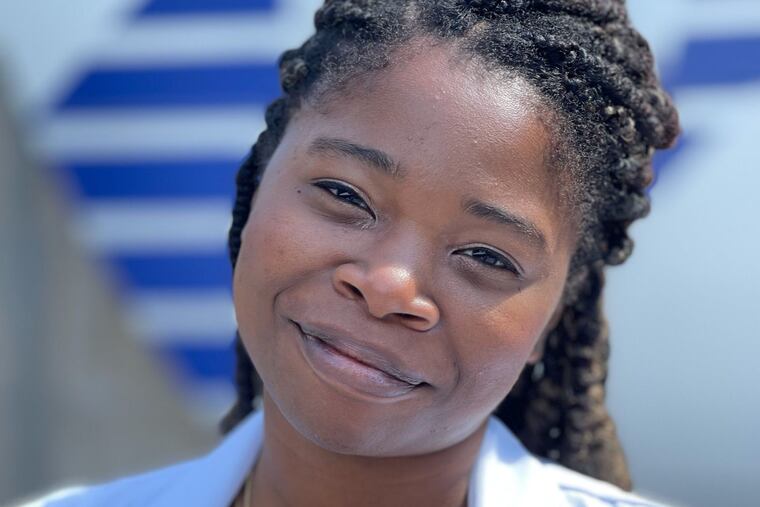How do we improve diversity in medicine? Black female physician-leaders answer
Jasmine Brown, a medical student at University of Pennsylvania, studied the lives of the first Black women doctors. She learned a lot about her own experience, too.

Jasmine Brown’s class of medical students at the University of Pennsylvania has about 170 students — 23 of whom are Black. Of those, she is one of 10 women.
In her new book, Twice as Hard, Brown unearthed the stories of the nation’s first Black female doctors. Through their careers and the obstacles they encountered, she chronicles the medical profession’s ongoing struggles with diversity.
She joined The Inquirer’s Telling Your Health Story virtual conference on Jan. 20 to talk more about her research and the challenges that persist in creating a more diverse and equitable medical workforce.
Brown was accompanied by Eve Higginbotham, the inaugural vice dean for inclusion, diversity and equity at Penn’s medical school; and Arlene Bennett, the first woman of color to earn a medical degree from Penn, in 1964.
Below is an excerpt from their conversation with Inquirer Health & Science editor Letitia Stein. To listen to the entire discussion, visit Inquirer.com/TYHS2023
What did you learn about the factors contributing to the continued under-representation of Black women in medicine?
Brown: There are many social and structural barriers that were put in place far in the past that still persist today.
Penn, as a predominantly white institution, probably has one of the better representations of Black women. I know of some schools that have close to 200 students and they have maybe one Black student, maybe two.
The national representation of Black physicians is still severely represented. Around 5% of all physicians are Black and about half are women.
One of the big factors I saw as contributing to this lack of representation was the Flexner Report in 1910. With this report, Abraham Flexner decided which schools he thought were legitimate and which were illegitimate.
(Editor’s note: The work of Flexner, a leader in shaping modern academic medicine, served to standardize medical education. Only more recently have mainstream medical leaders acknowledged how the racist ideas in his work affected the profession.)
Back in 1900, there were 160 Black female physicians. But in 1920, 10 years after the report, there were only 65.
Not coincidentally, Flexner had said most of the Black medical schools were illegitimate, leading to the closing of all but two — Howard University and Meharry Medical College. While he did have some experience to give insight to what schools might be able to persist into this new era of medicine, it was also extremely biased.
He exposed his racism in this report, saying Black physicians should only be treating Black patients, and the fewer Black physicians, the better. It can be shocking for us to hear now as we like to think, “Oh, these reports are objective, they’re only [for] the betterment of medicine.” But this was only a few decades after slavery. Many people still viewed Black people as less than.
He used his power to close so many Black medical schools. In the late 1800s, there were as many as 14, but after his report, there were only two.
After that report, the number of Black physicians overall was decreased significantly. In 1910, only 2.5% of all physicians were Black. In 2006, almost 100 years later, 2.2% of all physicians were Black. We see how significantly that one policy change and the closing of those schools affected the entire demographics of medicine.
As someone who has held leadership roles at multiple medical schools and has been on the forefront of diversity efforts, what have you seen as some of the most effective strategies for increasing diversity?
Higginbotham: Most recently, there was an analysis that if we had actually kept those [Black] medical schools open, we would have as many as 30,000 — 30,000 — more physicians of color. So certainly that was a structural impact.
I would say the most effective mechanism we have across all of academic medicine is holistic admissions.
There is still a lot of bias. People still think we as people of color are less than or different from, and we always have to prove ourselves.
Holistic admissions take into account the lived experience. What is it in your lived experience that will help you to be the best physician that we can actually graduate from any particular school? Who’s going to actually do the best job for a growing, diverse nation? It’s a matter of actually understanding why we are physicians and scientists. The “why” is because we want to make the world a better place, and who best to make the world a better place than a diverse workforce?
We notice across the country when medical schools take into account the lived experience, they become more diverse. They deliver physicians to the workplace who are more compassionate, who are more community oriented, who understand the social contract.
The programs leading up to medical school, which have historically been called pipeline programs, are programs that remain critically important because we need to see role models. We need to have more physicians who are seen in our elementary schools, in our middle schools, so students see what their future could be.
[Brown] mentioned there were only 10 women of color in [her Penn] class. In my class at Harvard Medical School in 1975, we had five.
So that means, at least comparing these two medical schools, we’ve only doubled in 40 years.